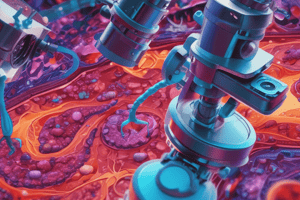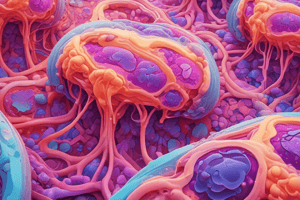Podcast
Questions and Answers
What is the main difference between light microscopes and electron microscopes?
What is the main difference between light microscopes and electron microscopes?
- Light microscopes use glass lenses while electron microscopes use magnetic lenses (correct)
- Light microscopes can achieve higher magnification than electron microscopes
- Light microscopes use visible light while electron microscopes use UV light
- Light microscopes are smaller in size compared to electron microscopes
Which of the following best describes the resolution power of electron microscopes compared to light microscopes?
Which of the following best describes the resolution power of electron microscopes compared to light microscopes?
- Electron microscopes and light microscopes have the same resolution power
- Resolution power is not related to the type of microscope used
- Electron microscopes have a lower resolution power than light microscopes
- Electron microscopes have a higher resolution power than light microscopes (correct)
What is the main purpose of using fluorescent stains in fluorescence microscopy?
What is the main purpose of using fluorescent stains in fluorescence microscopy?
- To enhance the contrast of the specimen
- To increase the magnification of the specimen
- To provide a source of UV or other light for the microscope
- To bind to specific cell macromolecules and make them visible (correct)
Which of the following best describes the relationship between magnification and resolution in microscopy?
Which of the following best describes the relationship between magnification and resolution in microscopy?
What is the main purpose of the condenser lens in a light microscope?
What is the main purpose of the condenser lens in a light microscope?
Which type of electron microscope is used to study the ultrastructure of tissues in ultrathin sections?
Which type of electron microscope is used to study the ultrastructure of tissues in ultrathin sections?
What is the purpose of the objective lens in a light microscope?
What is the purpose of the objective lens in a light microscope?
What is the primary function of microscopy in pathology?
What is the primary function of microscopy in pathology?
Why are electron microscopes required to operate in a vacuum?
Why are electron microscopes required to operate in a vacuum?
What is the resolving power of the human eye?
What is the resolving power of the human eye?
What is the typical size range of a eukaryotic cell?
What is the typical size range of a eukaryotic cell?
What is the main advantage of using a fluorescence microscope compared to a light microscope?
What is the main advantage of using a fluorescence microscope compared to a light microscope?
How do electron microscopes achieve different magnification levels?
How do electron microscopes achieve different magnification levels?
What is the approximate thickness of a cell membrane?
What is the approximate thickness of a cell membrane?
What is the maximum magnification power of a light microscope?
What is the maximum magnification power of a light microscope?
What type of microscopy is used to visualize sample surfaces?
What type of microscopy is used to visualize sample surfaces?
What is the typical thickness range for tissue sections studied by Transmission Electron Microscopy (TEM)?
What is the typical thickness range for tissue sections studied by Transmission Electron Microscopy (TEM)?
What is the purpose of adding compounds with heavy metal ions to the fixative or dehydrating solutions used for tissue preparation in TEM?
What is the purpose of adding compounds with heavy metal ions to the fixative or dehydrating solutions used for tissue preparation in TEM?
In TEM images, what do areas that appear bright (electron lucent) represent?
In TEM images, what do areas that appear bright (electron lucent) represent?
What is the highest resolution that can be achieved with a light microscope?
What is the highest resolution that can be achieved with a light microscope?
In SEM, what is the purpose of covering the sample surface with a thin layer of heavy metal?
In SEM, what is the purpose of covering the sample surface with a thin layer of heavy metal?
How is the complete image obtained in Scanning Electron Microscopy (SEM)?
How is the complete image obtained in Scanning Electron Microscopy (SEM)?
What is the primary purpose of microscopy in pathology?
What is the primary purpose of microscopy in pathology?
What is the key limitation of light microscopes compared to electron microscopes?
What is the key limitation of light microscopes compared to electron microscopes?
What is the primary function of the condenser lens in a light microscope?
What is the primary function of the condenser lens in a light microscope?
What is the typical size range of a eukaryotic cell?
What is the typical size range of a eukaryotic cell?
What is the purpose of using heavy metal stains in sample preparation for Transmission Electron Microscopy (TEM)?
What is the purpose of using heavy metal stains in sample preparation for Transmission Electron Microscopy (TEM)?
What is the main advantage of using a fluorescence microscope compared to a standard light microscope?
What is the main advantage of using a fluorescence microscope compared to a standard light microscope?
In Transmission Electron Microscopy (TEM), what is the primary reason for the appearance of areas that are darker (electron dense)?
In Transmission Electron Microscopy (TEM), what is the primary reason for the appearance of areas that are darker (electron dense)?
In Scanning Electron Microscopy (SEM), what is the primary function of the thin layer of heavy metal coating applied to the sample surface?
In Scanning Electron Microscopy (SEM), what is the primary function of the thin layer of heavy metal coating applied to the sample surface?
What is the primary advantage of using Transmission Electron Microscopy (TEM) over Scanning Electron Microscopy (SEM) for studying biological samples?
What is the primary advantage of using Transmission Electron Microscopy (TEM) over Scanning Electron Microscopy (SEM) for studying biological samples?
In Transmission Electron Microscopy (TEM), what is the primary reason for using very thin tissue sections (40-90 nm)?
In Transmission Electron Microscopy (TEM), what is the primary reason for using very thin tissue sections (40-90 nm)?
In Scanning Electron Microscopy (SEM), what is the primary reason for operating the instrument in a vacuum environment?
In Scanning Electron Microscopy (SEM), what is the primary reason for operating the instrument in a vacuum environment?
Which of the following statements best describes the relationship between magnification and resolution in electron microscopy?
Which of the following statements best describes the relationship between magnification and resolution in electron microscopy?
Which type of microscope is used to study the ultrastructure of tissues in ultrathin sections?
Which type of microscope is used to study the ultrastructure of tissues in ultrathin sections?
What is the main advantage of using a fluorescence microscope compared to a light microscope?
What is the main advantage of using a fluorescence microscope compared to a light microscope?
What is the primary function of microscopy in pathology?
What is the primary function of microscopy in pathology?
What is the typical thickness range for tissue sections studied by Transmission Electron Microscopy (TEM)?
What is the typical thickness range for tissue sections studied by Transmission Electron Microscopy (TEM)?
Which of the following best describes the relationship between magnification and resolution in microscopy?
Which of the following best describes the relationship between magnification and resolution in microscopy?
What is the main purpose of the condenser lens in a light microscope?
What is the main purpose of the condenser lens in a light microscope?
How do electron microscopes achieve different magnification levels?
How do electron microscopes achieve different magnification levels?
What is the approximate thickness of a cell membrane?
What is the approximate thickness of a cell membrane?
In SEM, what is the purpose of covering the sample surface with a thin layer of heavy metal?
In SEM, what is the purpose of covering the sample surface with a thin layer of heavy metal?
What is the highest resolution that can be achieved with a light microscope?
What is the highest resolution that can be achieved with a light microscope?
The resolving power of the human eye is 0.02 mm.
The resolving power of the human eye is 0.02 mm.
A typical eukaryote cell is commonly between 10 and 50mm in size.
A typical eukaryote cell is commonly between 10 and 50mm in size.
Cell membranes are about 7cm thick.
Cell membranes are about 7cm thick.
Light microscopes use ultraviolet light to magnify samples.
Light microscopes use ultraviolet light to magnify samples.
Light microscopes have a resolving power of 0.02 µm.
Light microscopes have a resolving power of 0.02 µm.
Electron microscopes operate in a non-vacuum environment.
Electron microscopes operate in a non-vacuum environment.
Electron microscopes use glass lenses to magnify tissue samples.
Electron microscopes use glass lenses to magnify tissue samples.
Fluorescence microscopy relies on the wavelength of visible light to visualize samples.
Fluorescence microscopy relies on the wavelength of visible light to visualize samples.
Light microscopes can achieve a maximum magnification of 1500x.
Light microscopes can achieve a maximum magnification of 1500x.
The resolution of an image can always be increased by further magnification.
The resolution of an image can always be increased by further magnification.
Transmission Electron Microscopes (TEM) are used mainly for observing the surfaces of samples.
Transmission Electron Microscopes (TEM) are used mainly for observing the surfaces of samples.
Scanning Electron Microscopes (SEM) operate with electrons modulated at different speeds.
Scanning Electron Microscopes (SEM) operate with electrons modulated at different speeds.
Fluorescent compounds used in microscopy have no specific affinity for cell macromolecules.
Fluorescent compounds used in microscopy have no specific affinity for cell macromolecules.
Acridine orange is an example of a compound that specifically binds to proteins.
Acridine orange is an example of a compound that specifically binds to proteins.
Resolution around 3 nm can be achieved with Scanning Electron Microscopes (SEM).
Resolution around 3 nm can be achieved with Scanning Electron Microscopes (SEM).
Light is transmitted through a condenser before passing through the sample in electron microscopes.
Light is transmitted through a condenser before passing through the sample in electron microscopes.
Scanning Electron Microscopy (SEM) uses a wider beam of electrons compared to Transmission Electron Microscopy (TEM).
Scanning Electron Microscopy (SEM) uses a wider beam of electrons compared to Transmission Electron Microscopy (TEM).
Areas that appear bright in TEM images are denser and bind heavy metal ions during specimen preparation.
Areas that appear bright in TEM images are denser and bind heavy metal ions during specimen preparation.
In Transmission Electron Microscopy (TEM), the electron beam scans the specimen surface to capture reflected electrons for image production.
In Transmission Electron Microscopy (TEM), the electron beam scans the specimen surface to capture reflected electrons for image production.
Heavy metal ions are added to the fixative or dehydrating solutions in SEM to enhance contrast and resolution.
Heavy metal ions are added to the fixative or dehydrating solutions in SEM to enhance contrast and resolution.
Electron microscopes operate in a vacuum to prevent electron absorption by air molecules.
Electron microscopes operate in a vacuum to prevent electron absorption by air molecules.
Scanning Electron Microscopy (SEM) produces black-and-white images by capturing transmitted electrons.
Scanning Electron Microscopy (SEM) produces black-and-white images by capturing transmitted electrons.
Flashcards are hidden until you start studying




